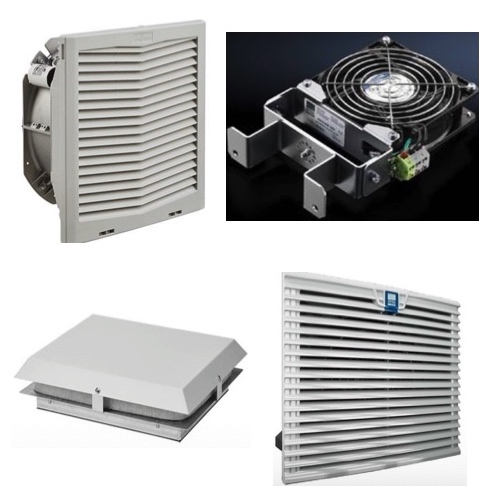Enclosure Fans

Enclosure fans are essential for managing heat inside electrical, electronic, and IT enclosures. These fans promote controlled airflow by removing hot internal air and introducing cooler ambient air, helping prevent overheating, component failure, and reduced system lifespan. Proper ventilation is critical for maintaining reliable operation in control panels, data cabinets, and industrial enclosures.
Common enclosure fan designs include filter fans, exhaust fans, slimline fans, and IT data cabinet fans. Filter fans draw in filtered air to protect sensitive components from dust and contaminants, while exhaust fans remove hot air to reduce internal temperatures. Systems may be configured for positive pressure, negative pressure, or a combination of both depending on enclosure layout, ambient conditions, and heat load requirements.
Most enclosure fans use axial fan technology to move high volumes of air efficiently. They are designed for flexible installation on enclosure doors, side panels, roofs, or hoods, supporting both intake and exhaust airflow configurations. Many models carry NEMA or IP ratings to ensure reliable performance in indoor, outdoor, and washdown environments where protection from dust and moisture is required.
FAQs
Q: Do enclosure exhaust fans cool air inside a cabinet?
Exhaust fans do not actively cool air but reduce enclosure temperature by removing hot internal air. This creates airflow that allows cooler ambient air to replace the heated air inside the enclosure.
Q: What is the difference between filter fans and exhaust fans?
Filter fans introduce filtered ambient air into the enclosure to maintain positive pressure and cleanliness, while exhaust fans remove hot air to lower internal temperatures. Many systems use both together for balanced airflow.
Q: Can axial fans reduce static pressure inside an enclosure?
Yes, axial fans help overcome static pressure caused by internal components or restricted airflow paths, improving air circulation within the enclosure.
Q: Are enclosure fans suitable for outdoor use?
Yes, many enclosure fans are rated for outdoor environments and carry NEMA or IP ratings to protect against dust, moisture, and environmental exposure.
Q: How do I choose the right enclosure fan size?
Fan selection depends on enclosure size, internal heat load, ambient temperature, airflow requirements, and environmental conditions. Proper sizing ensures effective heat removal and long-term reliability.
Why Buy Enclosure Fans from RSP Supply
RSP Supply offers a broad selection of enclosure fans for industrial control panels, IT cabinets, and electrical enclosures. Customers rely on RSP Supply for access to trusted manufacturers, detailed technical information, and knowledgeable support to help select the right cooling solution for reliable thermal management in demanding applications.

